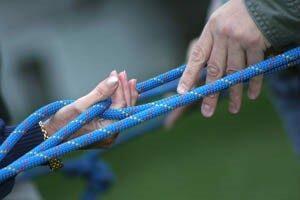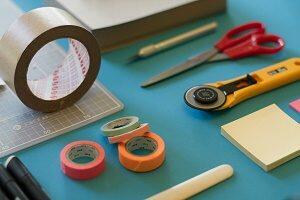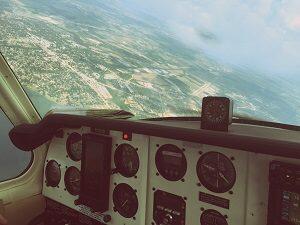Team building activities for work that help keep productivity, morale, output quality, efficiency and retention up.
It’s also essential to learning, innovation, and accountability.
In fact, name any important aspect of your business and chances are you can improve to create great teamwork!
To help you out with that, we’ve prepared this
51 Best Team Building Activities for Work.
This comprehensive list represents the best of the best from seasoned team building professionals who’ve put these techniques to work to help their clients build great teams.
Try them out, and your team can start outperforming themselves too!
1. DIY Mission Statement with Mad Libs
Maybe it’s time for your company to have a new mission statement… or several! This activity takes some prep work, beginning with your company’s actual mission statement.
Remove the important nouns, adjectives and verbs (but not all of them) and create a mad lib, leaving blank lines where the removed words used to be.
Then, divide your group off into partners. Each mini-team has two members: the word-supplier and the word-writer. The word-writer asks for a noun, verb or adjective, whatever is specified as missing from the “mission statement”, and writes in what the word-supplier gives.
Repeat the mad lib exercise and each time, tweak the words so that the statement improves and begins to truly represent the group.The idea really is to write a better mission statement.
Variation:
Don’t tell the teams what type of document they’re creating and see how silly the mission statements can get.
Why we love this one: This wonderful team building activity for work gets everyone to focus on what brings them together and how they fit into company culture. There’s a little bit of challenge, too, which we always love.
2. Web Crawler
Here’s another that taps into communication skills: good listening and good clear directions are key in this problem-solving activity that gets participants working together to navigate a spider web. To prep, tape string across a doorway in two places: about eye-level (around 5 feet or so, no need to be exact) and about waist level (around 3.5 feet).
 The idea is for team members to pass through the “web” without getting caught (i.e. without touching the string). The challenge, and this is where teamwork comes in, is for partners to work together on this one. One partner is the “web crawler” and the other is the one giving the directions. The web crawler may only move in ways his partner tells him to.
The idea is for team members to pass through the “web” without getting caught (i.e. without touching the string). The challenge, and this is where teamwork comes in, is for partners to work together on this one. One partner is the “web crawler” and the other is the one giving the directions. The web crawler may only move in ways his partner tells him to.
Once the first guy is through the web, he guides his partner through. Once they’re both through, they’ve succeeded. You may time the activity to make it even more competitive-see who gets through the fastest. You may need a judge, too, to make sure no team touches the web.
3. Essential Items
 Essential Items is a great one because it challenges your team in their decision-making processes. Divide your group into teams of 3-5. They must imagine that they were on an airplane which crashed. Luckily, they ended up on a tropical island so they survived.
Essential Items is a great one because it challenges your team in their decision-making processes. Divide your group into teams of 3-5. They must imagine that they were on an airplane which crashed. Luckily, they ended up on a tropical island so they survived.
What 12 essential items would they choose to have with them if they could pre-determine that sort of thing? Each team must collaborate, negotiate, and decide which 12 items they’d have. Make sure every one agrees on the decision. Each team will defend the decision if they are asked to defend their choices (which they will).
The catch? Well, there are two catches, actually. It is important that the 12 items rank in order of importance and those items are from your office building.
4. Team Building in a Minefield: Watch Where You Step
This one requires a large, unobstructed space, some masking tape, some squeaky toys and some sheets of paper. The tape is to mark off your “playing field”, which is oblong. The papers will have large “X”s on them, representing mines.
The squeaky toys are the goals. The idea is for teams to make their way from one end of the long taped area to the other without stepping on a mine. Teams are partners. The tricky part is that the one partner who is making his or her way through the minefield is actually blindfolded! His or her partner is the “guide”, offering explicit and timely suggestions on where to step and where not to step. He must stay within the boundary, pick up as many toys as possible, and of course, not step on any mines.
Why we love this one:
This is all about good communication skills. Clear and precise directions must be given and they must be given quickly enough to avoid a minefield disaster. On the flip side, it’s about listening carefully to what your partner is telling you. Good skills for the workplace!
5. Aviation Experts
 From the outside, this activity may look like a simple paper plane contest, but it’s not. Sure, teams will be constructing paper planes and testing them out to see whose flies the furthest. But it’s what goes into that action that makes this a team building activity.
From the outside, this activity may look like a simple paper plane contest, but it’s not. Sure, teams will be constructing paper planes and testing them out to see whose flies the furthest. But it’s what goes into that action that makes this a team building activity.
The group is divided into teams of 3-5.Each team is given some good heavy stiff paper to make their team plane from. Then, they are shown a variety of ways to fold the paper into paper planes. Using their best decision-making and communication skills, each team must decide which paper plane design will fly the best. Then, they use the directions and as a team make the plane. One person reads the directions, one does the folding, one oversees, etc… whatever roles they come up with is part of the challenge. Then, it’s time to test their choices with the actual paper place contest!
6. Airband Battle
Airband Battle requires some technical preparation: you will need some speakers and a smartphone because music is involved. The group gets split into teams of 3 – 5 and the first thing they do is assign roles.One is the guitar player, one is the singer, one is the drummer etc. You may choose the songs ahead of time, or let them choose.
Keep in mind the song should be appropriate for the office! Groups may also choose their own song. They rehearse, and choose props from among anything you might have supplied (get crazy and bring in wigs or keep it simple or nothing at all is OK too).
Groups perform their acts, and the winner is decided from someone outside the group. You can grab someone from down the hall or you can be the judge yourself.
7. The Common Thread
 The group is divided into teams of 4-8. They are given 10 minutes to find one common thread among them, like a hobby or a skill or taste in music. Write it down on a whiteboard, of which each team has its own. Then a team member is chosen to record the brainstorming session on the same whiteboard. Team members come up with a list of stereotypical characteristics of people who have that same common thread they just came up with. For example, if the common thread they came up with was “Sci-Fi Readers”, some stereotypes might be “nerdy” or “male”.
The group is divided into teams of 4-8. They are given 10 minutes to find one common thread among them, like a hobby or a skill or taste in music. Write it down on a whiteboard, of which each team has its own. Then a team member is chosen to record the brainstorming session on the same whiteboard. Team members come up with a list of stereotypical characteristics of people who have that same common thread they just came up with. For example, if the common thread they came up with was “Sci-Fi Readers”, some stereotypes might be “nerdy” or “male”.
Post-activity discussions include whether or not anyone in the groups actually fulfill any of the stereotypes and how these perceptions change the way we deal with people at work. Also talk about the process of finding that common thread.
Hopefully the idea of stereotypes will be shown to be silly and harmful to teamwork. It’s also a good activity to bond the team, as the purpose is to find a common thread.
8. To Tell the Truth
To Tell the Truth takes a little bit of creativity on team members’ parts but very little prep work on your end of things. All you need is 4 identical pieces of paper for each person. Each person is to write down four statements about him or herself, with one statement on each paper. The trick is: one of the statements is a lie! Then, go around the group and each person reads his or her four statements in any random order. Colleagues are to guess which one is the lie.
Why we love this one:
This falls into the team building as well as the team building categories. Some people at work have no problem letting everyone know what they’re all about, sharing things about themselves that allow everyone to understand them better.
However, introverts won’t likely find as many opportunities for self-proclamation. This activity allows them to share in a way that’s comfortable, acceptable, and pleasant, thereby leveling the playing field so everyone gets to know them better on equal footing.
And of course the more team members understand one another, the better they’ll be at teamwork.
9. Branding Your Desk
 Each participant must bring one object from his or her desk to the activity location. They are not told why. Begin the activity by forming teams of 3. Each group must choose from their items they brought. That one item will be their new product that they must sell.
Each participant must bring one object from his or her desk to the activity location. They are not told why. Begin the activity by forming teams of 3. Each group must choose from their items they brought. That one item will be their new product that they must sell.
The collaborate on a logo for their product, a name, slogan, and an entire marketing campaign for the item. They will need a spokesperson to talk up the object and the marketing campaign. Give them 20 minutes or more if they seem to need it. Then the presentations are made.
The idea is to practice seeing old things differently. Good practice in brainstorming, too.
10. Team Timeline
You’ll need a huge, long bulletin board (or anything that can take thumbtacks) for this one, plus string/yarn and half-size pieces of paper and markers.To prep, you will write on these papers with a marker the important markers in history of your company. For example, you’d start with the founding, then maybe any mergers or department expansions. Then, you’d have team members write four of their own important historical markers down, and place them along the company timeline.
Why we love this one:
This one works well because it places team members onto a visual map of your company’s history and allows for generational differences to be recognized in a positive way. Also, it’s yet another way for introverts to comfortably let others know a little bit about themselves.
11. The One Big Question
 To prep, come up with times in life where we’re asked to do something. Examples would be getting married, starting a new job, serving on the PTA, leading a community volunteer group etc. Present the scenarios one by one. In the meantime, ask team members to think of one question they’d ask someone to determine if they were ready for that role. That’s the One Big Question. Then reveal what everyone came up with and note the differences. It’s a good lead-in for discussion on how everyone sees things differently.However, diversity is good since all the questions will be useful.
To prep, come up with times in life where we’re asked to do something. Examples would be getting married, starting a new job, serving on the PTA, leading a community volunteer group etc. Present the scenarios one by one. In the meantime, ask team members to think of one question they’d ask someone to determine if they were ready for that role. That’s the One Big Question. Then reveal what everyone came up with and note the differences. It’s a good lead-in for discussion on how everyone sees things differently.However, diversity is good since all the questions will be useful.
12. Commercials
The group is divided into teams of 4-5 each. Each is given a product or a service to promote. They have 20 minutes to come up with a TV commercial for that product or service. Explain that they will have to choose roles: director, actors, etc, but they should all contribute to the production of the commercial they create. Then they perform their commercials and you can “judge” them if you like, or have the group vote on the best one.
This leads to a discussion of how we each take on roles at work according to our abilities, just like the activity where they chose roles they were best at.
13. What Did You Draw?
 Each person gets a pencil and piece of paper and the group sits in a circle around a table. Everyone draws something simple, then passes it on to the person to his or her right. Everyone then takes the drawing they received, folds the paper in half, and writes on the paper what he or she thinks the drawing is. Then the papers get passed along to the right again, and each person reads the description, then folds the paper again.
Each person gets a pencil and piece of paper and the group sits in a circle around a table. Everyone draws something simple, then passes it on to the person to his or her right. Everyone then takes the drawing they received, folds the paper in half, and writes on the paper what he or she thinks the drawing is. Then the papers get passed along to the right again, and each person reads the description, then folds the paper again.
That’s when they draw what they’ve read (the description). This continues until each person gets his or her own original drawing back.Then each person shows the progression of his original drawing to become what it did by the end of the circle.
Why we love this one:
This is a great ice breaker because it’s usually hilarious to see how much the original drawing has changed. It’s much like the game of Telephone, in which a verbal message gets passed along and by the time it comes full circle it’s completely different.
14. Grown-Up Show and Tell
This is an activity that for most of us ended during childhood. Too bad, since it’s a great way to learn about one another in a non-threatening way! Do this over time, perhaps at lunch or during afternoon sessions for a quick half hour team building activity at work.
Cycle through a list of group members at work, and each day is a different person’s turn. He or she brings in a small object that symbolizes something important to that person. It can be work-related or it can be personal…each person chooses what and how much they want to share.
The idea here is that not everyone at work finds a way to let his or her colleagues know about himself or herself. Usually the dominant types end up doing all the “sharing” when the group is left to its own devices. By setting aside time for each person, the team gets to know everyone, not just the loud-talkers.
It’s a good lead-in to how teamwork is that way, too: the group has to find ways that everyone gets to put in his or her own two cents’ worth.
15. Celebrity Problem-Solving
Celebrity Problem-Solving is problem-solving taken to extreme measures. It revolves around current events, but can be played with a fun sense of humor that lightens the scene for everyone. To prepare, scan current events for celebrity news and find a few examples of celebrities who have had run-ins with the law, personal disputes with cheating spouses, or whatever else sports heroes, film stars and other celebrities have gotten themselves into lately.
The more people the better for this one- divide your group into teams of four. Have each group collaborate to come up with a solution for the celebrity in question.
Each team must create a single solution, and they must agree on that solution, much like a jury must be unanimous. If there’s time, have each team solve a series of different celebrity problems. Then, have the groups choose a spokesperson to share their solutions with the other groups. The groups then discuss to determine which group has best solved each celebrity issue. A “final solution” is voted upon.
Why we love this one:
The lively discussions that ensue after the sharing of solutions are wonderful for team building. Voting on the “final solution” brings the group together and achieves a nice sense of teamwork that can be transferred back to the workplace.
16. Scavenger Hunt
 Teams are formed and given a list of items to go and find and collect. You can do this in-office our outside or even around town if you are super ambitious. The team who returns first with all the items on the list is the winner. Set a time limit of at least an hour. The prep is the hard part, since you have to think of appropriate items for the teams to collect. You can do a theme, or base the hunt around a holiday.
Teams are formed and given a list of items to go and find and collect. You can do this in-office our outside or even around town if you are super ambitious. The team who returns first with all the items on the list is the winner. Set a time limit of at least an hour. The prep is the hard part, since you have to think of appropriate items for the teams to collect. You can do a theme, or base the hunt around a holiday.
Teamwork is essential to success on this activity, and if you include clues, creativity comes into play as well.
17. Zombie Escape
Zombie Escape is for teams who already have a certain level of comfort with one another. We never like to suggest outlandish activities for groups who have never met one another because the risk of some people feeling uncomfortable with team building activities like this is too great. That being said, this is a fun team building activity for work if you can swing it. There is quite a bit of prep work, but if you prepare well, this can be a great activity for practicing creative problem solving.
The idea is for your group to solve problems you devise before a zombie gets them!You’ll need a rope, which you will tie around the waist of one lucky volunteer who gets to be the zombie. You’ll also need a large room that’s free of clutter and furniture.
“Tie” your zombie up in the corner of the room, leaving only a few feet of rope for him/her to reach out into the room. Every five minutes, your zombie gets another foot or so of rope let out. If he can touch a team member, the game is over and the zombie has “eaten” everyone in the room. The team avoids this unpleasant death by solving the problems/puzzles/obstacles you gave them at the beginning of the game.
Each time they are successful with a solution, they get a clue as to the whereabouts of a key you have hidden in the room somewhere. Once they find the key, they get to “unlock” the door and escape the zombie.
Why we love this one:
It’s not every exercise that gets everyone collaborating with such an intensity that you’ll witness when you try Zombie Escape.
Of course everyone wants their team to be great at creative problem solving, which this activity really encourages. You can devise”problems” that are thematic, or which fit with a company initiative, too. You can even tailor the exercise to involve physical obstacles, or mix and match.
It’s great fun to get creative when you set this one up!
18. Geocache for the Group
Same idea as the Scavenger Hunt, only it’s more high-tech. You still make teams, give clues, and have them find things. The difference is that now they have GPS coordinates to help them locate the items on their lists. You’ll need GPS devices or more likely smartphone apps.Make sure to set a time by which everyone must be back at”home base”. Again, this is great collaboration and problem-solving practice.
19. Blind Drawing
 Sometimes a good ice breaker is all you need. This is a classic one, based on the principle that good communication skills will always take you far. The group is partnered off and each partner sits back-to-back. One person gets a picture of something simple, not too elaborate. He or she must describe that object to the partner, who draws according to those verbal instructions.
Sometimes a good ice breaker is all you need. This is a classic one, based on the principle that good communication skills will always take you far. The group is partnered off and each partner sits back-to-back. One person gets a picture of something simple, not too elaborate. He or she must describe that object to the partner, who draws according to those verbal instructions.
The challenge for the person with the picture is to find a way to describe the object without actually naming it. The challenge for the “artist” is to listen carefully and carry out the instructions given him or her.
Why we love this one:
This is simple enough that anyone can feel comfortable participating, and also loads of fun. Those are the two essential characteristics of a good ice breaker, by the way! Plus, this ice breaker is a step above a mere game in that it tests communication skills, so doing double duty means it’s a keeper.
20. Egg Drop
Although this is technically a team building activity for work, it’s a light-hearted approach to collaboration and problem-solving that may work for some groups but not others. You will need a carton of eggs, plus construction materials like newspaper, bubble wrap, rubber bands, cardboard, empty boxes, and other simple materials that can work as padding or packing materials. The idea is for each team to work together to construct a padded container for their egg.
They must find a way to protect the egg because their padding job will be tested by a drop from a rather high spot (obviously you’ll want to do this outdoors or at least on a non-carpeted surface!). If everyone’s egg survives the drop, go higher until you have a winner.
Why we love this one:
The goal is very simple and easy to visualize, so it’s easy for every member to understand and participate in this fun team building activity. Of course one of the goals of team building is to get everyone involved, so we rank this activity up there with some of the best, even though at first glance it’s incredibly simple.
21. What Makes You Tick
What Makes You Tick involves having your team take a personality assessment together. The object is to learn about each other’s personalities of course, but the real goal is to understand how these various personalities may clash in everyday scenarios. Bring in a speaker or someone who can help the group interpret the results of their personality assessment (we don’t like the term “personality test”, because it implies there’s a right way and a wrong way to be).
A good model to use is the DiSC Personality Assessment, which certifies its instructors to help groups who carry out exercises like this one. DiSC offers participants easy-to-remember and simple assessments of their personalities, so it has become quite popular in corporate settings. In future teamwork scenarios, groups can remember each other’s personality types and when conflict arises or communication breaks down, it may help to remember who’s who in terms of personality type.
Why we love this one:
One of the keys to good communication and great teamwork is understanding what motivates your team members. Personality dictates behavior, which in turn determines how people communicate. By understanding that someone is the type who needs everything spelled out for them, for example, you’ll be better able to judge where their behavior is stemming from, and adjust your own expectations accordingly.
22. Living History
Living History is a team building activity for work that involves a huge group scrapbook that’s placed in a common area at work. Over a period of about two weeks, the team is instructed to add to it according to prompts you have put in the book, such as questions or instructions.
Here are some examples of things to add to your group’s scrapbook:
What types of positive change did you witness today?
Describe some collaboration that you took place in this week.
What did your team accomplish today?or as light as what did you have for lunch? Participants may also draw in the book and paste things in, too.
Quotes are nice, or anything that supports your team’s culture. The living history that results provides great fodder for team-building activities for work. It strengthens team bonds, brings people together, and provides a snapshot in time of your team that will be interesting to look back on in six months or a year.
23. Puttin’ Pantry
 Puttin’ Pantry has several parts to it, and the result is a donation to charity! The group is divided into teams of 4-5 and each team is given a huge pile of pantry items to work with (cereal boxes, soup cans, etc). They have 15 minutes to use those items to build a mini golf course.After the 15 minutes, you provide golf balls and clubs, and the teams try out their courses.
Puttin’ Pantry has several parts to it, and the result is a donation to charity! The group is divided into teams of 4-5 and each team is given a huge pile of pantry items to work with (cereal boxes, soup cans, etc). They have 15 minutes to use those items to build a mini golf course.After the 15 minutes, you provide golf balls and clubs, and the teams try out their courses.
Votes are taken on the best one. Finally, courses are taken down and the food items are donated to a local food shelter.
24. Inventors
Inventors challenges teams to design something that moves a golf ball from Point A to Point B. They are given primitive building materials (anything you like: straws, paper dowels, toothpicks, an assortment of cardboard shapes etc). They get 10 minutes to construct their device and the final results are hilarious. Problem solving in action here, as well as working with limited resources.
25. Toxic Waste
Another light activity for team building at work is what we call Toxic Waste. Consider it an elaborate ice breaker if you will, which can make the transition between ice breakers and the real “meaty” team building activities that require more high-level thinking. The idea of Toxic Waste is for your group to find a way to transfer tennis balls from one bucket to another using only a giant set of bungee cords.
The tennis balls are the “toxic waste”, and are placed inside a small bucket. That bucket of toxic waste is “contained” within a circle which you mark out with a rope or string on the floor of your event space.
The waste must be transferred to a larger bucket, which is placed at least 20 feet outside the circle. Team members must not touch the toxic waste with any part of their bodies, especially their hands. Anyone who steps inside the circle is injured. Anyone who drops the waste during transfer is injured.
If the team knocks over the small bucket of waste, everyone “dies” and the game is over (or they can start again if you want).
Why we love this one:
Teams must come up with original, creative solutions to their problem, which is something every manager likes to encourage on their team.
The activity isn’t based on any physical skills, so it’s non-threatening for everyone. Even someone who’s in a wheelchair may be a productive part of the team on this one.
26. Sort it Out
 The idea is for the group to create a story from pictures each team member is given. You should have at least 5 people on each team. You will need a random picture for each person a team. However many teams you have, you will need identical sets of pictures so each team ends up with the same set of pictures.
The idea is for the group to create a story from pictures each team member is given. You should have at least 5 people on each team. You will need a random picture for each person a team. However many teams you have, you will need identical sets of pictures so each team ends up with the same set of pictures.
The goal is for each team sort out their pictures and collaborate on a story that’s cohesive, yet based on their random, unrelated pictures.
The challenge: team members cannot show their individual pictures to their teammates. This requires everyone to listen carefully to what their teammates are saying, and for everyone to communicate very clearly.
Teams then present the stories they wrote, and it’s interesting to note the differences in stories even though each team started out with the same set of pictures. A good follow-up is an activity that stresses the importance of having diversity on a team.
27. Find Yourself, Find Your Partner
Find Yourself, Find Your Partner is an activity that has many names, but whatever you call it, it works very well as an icebreaker for groups who may not know one another very well. Remember the old game where you have a famous person’s name taped to your forehead and you have to go around the room asking people questions until you figure out who you are?
This is a variation on that. Instead of a famous person’s name taped to your forehead, you have part of a pair of items taped to your back. For example, a common pair is salt and pepper. Or peanut butter and jelly. You have to circulate and ask yes or no questions to figure out what you are (not “who” you are).Once you know what you are, you must keep circulating to find your partner.
Again, people may only ask yes or no questions. Once you find your partner, you sit down and make a list of three things you each have in common as employees of your company or as people. Examples would be: you both work in IT, or you both own cats.
Why we love this one:
Sometimes team building serves double duty and acts as a networking event, too. Any activity which gets people milling about and circulating among each other, communicating for a specific purpose works wonderful as a networking activity.
28. Common Ground
Common Ground is an activity that has several stages, each with its own lesson. Teams are made, with each team around 4 to 6 people. Each group gets a large piece of cardboard, at least 3 by 2 feet. They get 2 minutes to brainstorm and come up with one word. This word must describe something each team member has in common with the others. They write the word on the piece of cardboard with a big marker.
Now comes the creative part: each team is given a tube of toothpaste. Their job is to outline the word they just wrote with the toothpaste as creatively and as neatly as possible. They get two minutes for that, too, while they decide who should do the lettering. Then discuss each team’s creativity for a bit, plus the words they chose.
Now comes the silly part. Each team gets another two minutes to put the toothpaste back into the tube! Of course it can’t be done, so at the end of two minutes time is up and you will ask for their feedback. Ask the group what they think the activity was supposed to teach them. There are many correct answers of course: creativity, teamwork, collaboration, etc.
However, you have your own spin on things: just like toothpaste can’t be put back into the tube, words that come out of your mouth cannot be put back, either. That’s why it’s so important to choose our words carefully, just as they did at the beginning of the activity!
29. Leaning Tower of Spaghetti
If you think your group can handle fabricating small structures with basic craft supplies, then this is a good challenge.Like many others in this list, this is really an elaborate ice breaker. It does get teams collaborating but of course we really like it when skills used during a team building activity for work are easily transferable to the office.
You be the judge!
You will need a box of uncooked spaghetti and a small bag of large marshmallows, plus masking tape and string. Each team gets 20 strands of spaghetti, one marshmallow, a yard of string and a roll of masking tape. Their job is to construct a tower (the tallest wins) out of those supplies.
The challenge: the marshmallow must be the highest point of the tower. The goal: the tower must stand on its own for a minimum of 5 seconds! The tower cannot lean on anything, either. The test: each person on the team must have played a role, where they can point to the area of the tower they were responsible for. This prevents any single team member from monopolizing the job.
Why we love this one:
As you can tell, this requires some pretty good problem-solving and collaboration skills!
30. Square-Off
 You’ll need a long rope (5o feet) and some blindfolds. You will need at least 8 people to be rope-holders. The rest will be observers. The rope is tied into a circle. Rope-holders are blindfolded, and each given a place on the rope to hold onto. They are told that they have to make the rope into a square shape, blindfolded.
You’ll need a long rope (5o feet) and some blindfolds. You will need at least 8 people to be rope-holders. The rest will be observers. The rope is tied into a circle. Rope-holders are blindfolded, and each given a place on the rope to hold onto. They are told that they have to make the rope into a square shape, blindfolded.
The process happens through communication, with the group trying to reach consensus using verbal skills only. Meanwhile, the “observers” are noting and writing down how the group reached the consensus. They should notice whether everyone provided input to the solution, how many different communication styles were used, and whether someone had a good idea but wasn’t making themselves heard.
Then, the observers choose a spokesperson and share their thoughts on how the rope-holders did with teamwork. This is a good lead-up to a discussion on group dynamics or leadership.
31. Pursuit of Trivial Office Knowledge
More than a simple trivia game, this activity supports company culture and cohesion in a way that you can incorporate a specific message of these, if you so desire. The idea is for teams to compete by successfully answering trivia questions which test their knowledge of company culture.You write the questions beforehand, so of course there’s quite a bit of preparation. A good tip is to begin with your company manual.
Look for historical events, such as what year you were founded or incorporated, what year the current CEO began, etc. Divide the group into teams of 3 or 4, depending on the size of the group. Each team first creates a name for themselves which must include the name of the company in it.
For example if your company is called “IBM”, team names could be “The IBM Brain Trust” or “The Incredible IBMers” (hopefully teams will be a bit more creative than that)! For each question they answer correctly, teams get points. At the end, the team with the most points wins something.
Variation:
Write trivia questions of varying degrees of difficulty and assign more points for the hard ones.
Why we love this one:
This is a good way to foster company loyalty and push company-wide initiatives or a team message. You can even customize it for holidays, events or themes. It can also be tailored around a specific company product ahead of a big launch, to generate enthusiasm and group cohesion.You can also get creative with the prize, which can range from something tangible like gift certificates to office perks.
32. Frisbee Clinic
You will need a few Frisbees for this activity. The group is divided into teams of 5 or so. Each team gets a Frisbee. Members of the team work collaboratively and brainstorm the skills they think one needs to throw a Frisbee. Ideas are written on a whiteboard, one for each group. After 10 minutes, they form a circle and then begin throwing the Frisbee, noting whether or not the skills they wrote down were accurate.
Then they re-group and adjust their list of skills, if needed. Finally, the facilitator asks for “reports” from each group, and it’s fun to find out which skills were listed by each team. It’s a good way to point out that even the simplest of tasks require a broad range of skills. This dovetails into a discussion of how it’s good to have a diverse team with a diverse set of skills.
33. Arctic Chill
 Here is another which goes by many names but we like to call it “Arctic Chill”. Your team will imagine they’re a group of Arctic explorers who must construct a shelter before the already-cold weather turns stormy and they’re hit by a strong wind.
Here is another which goes by many names but we like to call it “Arctic Chill”. Your team will imagine they’re a group of Arctic explorers who must construct a shelter before the already-cold weather turns stormy and they’re hit by a strong wind.
The “shelter” will be a miniaturized, crude structure built from card stock, rubber bands, sticky notes, rubber bands, or whatever else you come up with as far as craft supplies are concerned.
The “storm” will come from an electric fan which you will turn on when the teams run out of time to construct their shelters. Teams should be three to four members each. Each team will pick one member as their team leader.
This person cannot use his or her hands to help the group construct the shelter because of frostbite. Also for the remaining team members, they will face a challenge as well because they will suffer from snow blindness and won’t be able to see a thing (you will need blindfolds).
Using good communication skills, the team works its way through the challenge, attempting to create a shelter which will survive the “wind” you are about to unleash on them. You can use a timer to set the pace.
Variation:
For an extra challenge, keep the fan on at a low setting while teams build their shelters.
Why we love this one:
You may have guessed this already, but this is a good test of communication and collaboration skills. The blindfolds ensure that good, clear communication is necessary for successful completion of the shelters, and the handicaps require everyone to work together as a team for collaboration.
34. Networking Bingo
Networking Bingo is a great networking ice breaker, since it has the group circulating to find answers to pre-set questions. You will need to prepare your own Bingo cards in advance, and each participant gets one card as they enter the room. Have each person obtain signatures from different people in the room on each square. When you find someone who fits the description on the square, then you collect a signature from them. Examples range from personal characteristics to work-themed ideas: someone who uses a Mac at home, someone who was born in November, someone who is good at research, someone who works in IT. After everyone has filled their cards, call out participant names until someone gets a “Bingo!” Post-activity discussion can include questions, for example, “What new talents did you discover in your group?” or “Which squares were easy?’ or “Did you find one that was hard?”
35. Tag Cloud/Memory Cloud
 Here, we have an activity that works best with employees who work with one another on a daily basis, rather than strangers who rarely see each other or who don’t know each other very well. The idea here is to create a tag cloud, if you are familiar with the term. If not, consider it a memory cloud or memory wall. The end product is a huge collage of sticky notes that represent positive team memories or group accomplishments.
Here, we have an activity that works best with employees who work with one another on a daily basis, rather than strangers who rarely see each other or who don’t know each other very well. The idea here is to create a tag cloud, if you are familiar with the term. If not, consider it a memory cloud or memory wall. The end product is a huge collage of sticky notes that represent positive team memories or group accomplishments.
Each sticky will have either words or pictures, symbolizing these memories.First prepare and write down a few topics on the wall or board. Assign each topic to a different team. Examples would be “Teamwork” or “Wins” or “First Day at Work”. Each team gets a topic and team members create their sticky notes, which symbolize their own take on the subject. They share their stories, then the group leader has everyone attach their sticky notes to the overall tag cloud/memory cloud so in the end you have a nice mural for the break room.
Why we love this one:
This is another one that’s good for drawing out introverts, who may find it challenging to let people know about them without a formalized structure to coax it out of them.
36. Values
Values are a slightly controversial and challenging so only use it for groups who know one another well and who can handle it. Each person draws a card from a deck of cards. They do not look at it. Instead, they slip it into a stretchy headband or baseball cap, which you will supply. Now everyone has a number but nobody knows their own.
The higher the value of the card, the more prestige and respect that person will have in this activity. In other words, the higher the card value, the higher the value of that person’s input on the team. Then, give them a task to perform that requires collaboration. Make it simple! They should treat one another according to the value of their various card values.
Next, ask them to line up according to how they feel according to card value.
Ask someone why they stood in the line where they did, what make them feel that way. Stress to the group that everyone can give helpful input, no matter what their position at work.
37. Emerging Leaders
 Lots of team building activities for work involve assignment of roles… leaders, builders, note-takers etc. This activity works in the opposite way. Teams perform the task, which you’re about to read about, and afterwards see if any leaders emerged as a result of the activity. You will need a huge metal washer for this one, plus some string and some tennis balls. If you can’t find these objects, you can substitute other objects for them instead. The washer should have a hole which is no bigger than the tennis balls.
Lots of team building activities for work involve assignment of roles… leaders, builders, note-takers etc. This activity works in the opposite way. Teams perform the task, which you’re about to read about, and afterwards see if any leaders emerged as a result of the activity. You will need a huge metal washer for this one, plus some string and some tennis balls. If you can’t find these objects, you can substitute other objects for them instead. The washer should have a hole which is no bigger than the tennis balls.
Make sure when you carry the ball that it does not slip through the washer. Tie the string around the washer, and make each around two to three feet in length. The strings radiate outward from the center, like spokes on a wheel. Each team is 3 or 4 members, and every person on the team holds a string. The idea is for the facilitator to place one tennis ball on each team washer, and instruct the teams to work together to walk the whole thing across the room to where they must drop the ball into a can or a bucket. If they drop the ball they start over again at the beginning of the course.
Why we love it:
The genius of this one is in the follow-up discussion. You ask each team to identify whether a team leader emerged during the tennis ball challenge. If so, they name who it was and then tell the other groups how their leader helped them accomplish their goal during the activity. It’s a great lead-in to a group discussion of leadership and teamwork in the office.
38. 3D Poster

You will need a poster for this activity: one for each team of 4 – 5. The poster should represent a team building concept like communication, collaboration, or charity work. First make teams. Each team will need a “seer”, a “communicator”, and the rest are poster makers. Only the seer gets to see the poster you’ve supplied. He or she is located as far as possible from the poster-makers. The seer communicates verbally to the communicator what he sees in the poster. The communicator’s job is to head over to the poster-makers and tell them now to reconstruct the poster in 3-D form. The communicator may go back to the seer for additional instructions as many times as he or she needs. Take pictures of the final results, and compare with the actual poster. Great fun, and great communication skill practice.
39. Flash Mobbing for All-Star Teams
Flash Mobbing is definitely a team building activity for a special kind of team. It involves an assumed level of cohesiveness and trust without which this activity would not be appropriate. It’s also for a rather extroverted group, or at least one which has already found a way to include everyone for most tasks.In case you didn’t already know, flash mobbing is when a group appears suddenly in public and performs a random act for a short period of time.
You can make the act silly, pointless, thought-provoking or branded. The mob will disperse all of a sudden and then it is all over. Examples would be an impromptu song, a chant, or some sort of short performance. It can even be wordless, involve flashcards or other props. Some of the biggest corporations use this particular activity for team building with great success. Only you know whether it’s right for your group!
Why we love this one:
While it only works for certain groups, it can be a wonderful team-building activity that creates some pretty zany team memories. If you have a member with a mobility challenge you can easily modify it for them. Also introverts don’t need to worry about being extroverts either.
We love that you can use this activity to spread the word about an upcoming company event, a product launch, or to fulfill other branding initiatives you may have.
40. Trash Compactor
Do you remember the trash compactor scene in Star Wars? Luke Skywalker, Chewbacca, Han Solo and Princess Leia became trapped inside the trash compactor and the walls started to come in on them almost crushing them. That’s how this challenge is based.
First, surround a team with a roped-off circle. As the circle gets smaller, the team will collaborate to figure out how to stay within the boundaries of their rapidly shrinking space.
41. Coat of Arms
A coat of arms traditionally designates geographical location and family pride. But a company coat of arms can show so much more. Use them to symbolize company achievements, company values, and company vision for the future. Provide a structure and framework for your group’s creative work by setting them up with some starter ideas. They don’t even have to be good: simply reading them and thinking about them will get the creative juices flowing. The finished coat of arms will be a three-part drawing, symbolizing these three ideas: achievement, values, vision. If your team is small, the entire group works together.
If your team is large, divide them into several groups, with each one working on a separate piece of the coat of arms.
Either way, they’ll have to choose an “artist” who will draw the final picture.They should also choose a record-keeper, to write down all the brainstorming ideas the group comes up with during the creative process. They should also choose a spokesperson who will explain the final product to the group.
Why we love this one:
Having your group create a company coat of arms together is a wonderful way to encourage collaboration and creativity. It’s also a fun way to practice good communication skills.
42. A Web of Support
You will need one very large ball of yarn (not a skein but an actual ball of yarn), plus a 10-inch rubber ball or a balloon. The activity is simple: participants stand in a circle. You ask a loaded question that fits your objectives. Each person in the circle answer the question in turn. The first person is holding the large ball of yarn. He answers, then throws the ball to someone else to answer. The catch: each person must hold on to the end of the yarn before he throws the ball. In that way, they all become “connected”, and create a web.The questions can be: What makes a good leader?Why do you value working on this team?
What do our customers need from us?… etc, in a similar vein.You can ask a second question to strengthen the web of yarn. Then, put the large ball or balloon in the center of the web. That represents the team, your customers, whoever you are serving or supporting. Ask the team to bolster the support by tightening up their web… very symbolic so debriefing discussions will tend to be very good.
43. Puzzle Barter
 If you have a lot of time set aside for team building activities for work, Puzzle Barter is a wonderful way for high-performing groups to practice their negotiation and communication skills. First you will create teams and team will get a jigsaw puzzle. They must complete their puzzle as a group within a given time frame. The catch: some of the pieces in belong to another group’s puzzle. Plus, some of the other team’s pieces will be in their pile. The idea is for teams to communicate for bartering purposes in order to get the pieces they need. They can exchange team members, give some of their allotted time to another team, merge together to form one huge team… whatever it takes to get their pieces and complete their goal on time!
If you have a lot of time set aside for team building activities for work, Puzzle Barter is a wonderful way for high-performing groups to practice their negotiation and communication skills. First you will create teams and team will get a jigsaw puzzle. They must complete their puzzle as a group within a given time frame. The catch: some of the pieces in belong to another group’s puzzle. Plus, some of the other team’s pieces will be in their pile. The idea is for teams to communicate for bartering purposes in order to get the pieces they need. They can exchange team members, give some of their allotted time to another team, merge together to form one huge team… whatever it takes to get their pieces and complete their goal on time!
Why we love this one:
Creative problem solving in many forms takes place during this activity! First, teams must do their puzzle. Second, they must negotiate creative solutions. Third, they must communicate their bartering ideas creatively so that other teams go for them.
44. Differences
This activity is a good icebreaker or lead-into a larger theme of the importance of diversity in teamwork. Each person in the group gets a piece of paper. They close their eyes and listen to instructions from you (or from a volunteer if you prefer).The instructions are: hold the paper out in front of you, fold the paper in half, fold it in half again, then form a triangle with the paper, then rip off the lower right corner, open your eyes, unfold the paper. Note the differences in each person’s creation
Even though everyone heard the same instructions, and the task we incredibly simple, each paper will differ slightly from the rest simply because we are all different and interpret things differently. As a result, you get a wonderful variety of outcomes on whatever you do in teamwork.
Ask the group to think about how this illustrates differences among them, and how that affects the group, and what they learned and how it may apply to teamwork in the office.
45. Make Due
Here, you have to come up with a project that involves using physical objects as resources. For example, devise an activity where teams must create a small toy-sized “vehicle” which can carry a ream of paper across a distance. Once you’ve thought of the particular challenge you’d like to present your team, now think of a way to limit their resources. For example, for the paper-carrier mentioned just above, give them only simple building materials to work with: plastic straws, paper plates, and string, for example. Teams get 20 minutes, and they take the project goal and use their limited resources to see what they can come up with. The final activity is for teams to share how they solved their problem to accomplish their goals.
Why we love this one:
Very often in the workplace an employee will have to complete projects where they use limited resources. The idea of “making due” is fast becoming a lost art, but teams who are adept at working with limited resources become more efficient in the end. We also love that creativity comes into play on this one as well.
46. Roundabout Truths
You will need enough chairs so each participant has one. Arrange the chairs in a huge circle and everybody has a seat. The objective is to move around full circle until you reach your original chair again. To prepare for the activity, each person gets a set of small objects or papers to represent him or her. There should be a total that equals the number of participants. These will be markers, to show how far they get around the circle.
If a player gets to move ahead one chair, he or she gets to place his or her marker under the chair.In order to move ahead, (to the right) one must be able to say “that’s true” of the statement you will read aloud.
For example, you might say: Move right one chair if there is a P in your first name.
First you may speed up the game by allowing two-chair moves: Move right two chairs if you drive an electric or hybrid vehicle.
You can also give set-backs in the form of a left-moving statement: Move left one chair if you were late this morning or Move left two chairs if you are wearing jeans right now.
Also you may make this so it is themed, trivia-related, or just plain silly: your choice!
47. Mini World
 You’ve heard of Lord of the Rings, right? Tolkien invented not only a mini world but also a language… an entire world, complete down to the detail with various species, hierarchies, and more. In “Mini World”, teams do something similar, although on a much smaller scale.Teams create their own mini society. It can be an economy or it can be a governing body. The idea is for them to create the society together, then devise rules for it. It helps if you can give guidelines. For example, if you want them to create a mini economy, tell them it must involve natural resources such as trees, for example.
You’ve heard of Lord of the Rings, right? Tolkien invented not only a mini world but also a language… an entire world, complete down to the detail with various species, hierarchies, and more. In “Mini World”, teams do something similar, although on a much smaller scale.Teams create their own mini society. It can be an economy or it can be a governing body. The idea is for them to create the society together, then devise rules for it. It helps if you can give guidelines. For example, if you want them to create a mini economy, tell them it must involve natural resources such as trees, for example.
Why we love this one:
Various team roles will emerge during this activity, and it will be interesting for the group to see who emerge as leaders and who emerge as followers. Other roles you can watch for are organizers, peacekeepers, detail people and challengers (as in “that won’t work because A,B,C”).
48. Random Promotions
Random Promotions is similar to “Roundabout Truths”, just above. The difference with prep is that you remove one chair so one person must stand in the center of the circle. The person in the center makes a statement promoting certain people: For example you can promote people who own cats. Another example you can do is promote people who ride bicycles to work.
The people who fulfill the promotion statement must move to another chair… one vacated by another person who gets to promote. The last one standing is now the person in the center making the next round of promotions.
This is a timed game, and more of an ice breaker and get-to-know-you activity.
50. Differences 2.0
Another icebreaker which leads nicely into a themed discussion or additional activity involving differences and dealing with diversity. After group introductions, participants stand in a large circle and one person gets a nerf ball or similar large, soft ball that’s easy to catch and harmless if dropped. He or she throws it to someone in the group, after some sort of verbal “heads up”, preferably using names. The ball makes its way around the circle, each person throwing it to someone else. Next introduce a matching ball. Each person throws the ball to the same person as they did the original ball. The pattern will be the same.
Then, introduce a third ball that’s completely different from the first two. It can be a tennis ball or a shaped or highly textured ball. Give it time to make its way around the circle several times, then stop the activity for a discussion. Discuss how that third ball was different and whether that caused problems. The group will most likely have established a routine for throwing the first two, and will have had to make adjustments in their throwing and catching styles for the third. Talk about how communication is the same way…sometimes we must make adjustments in how we speak and respond based on different styles of communication.
51. Balloon Skyscrapers
Balloon Skyscrapers is problem-solving and working with limited resources at its best. First divide the group into teams of 3 – 4 people each. Then, give each team 50 balloons and a roll of masking tape. They are given 15 minutes, and teams must make a free standing tower out of the balloons.The catch: the skyscraper must be freestanding, not taped to the wall or the ceiling or any furniture. You can buy some balloon inflators if blowing up balloons will be a challenge for your group. Post-activity discussions are great: ask each to explain their design and why they thought it would work. Note: the instructions do NOT tell groups to compete to build the tallest skyscraper. Part of the discussion afterwards is to see whether they turned the activity into a competition!
Team Building Resources for Work Workshops
Have a facilitator walk your team through any of our interactive team building workshops at your location.


